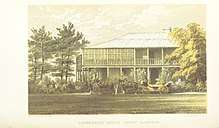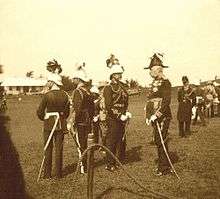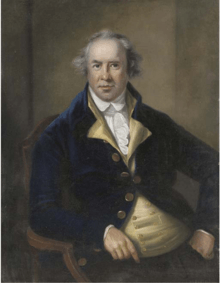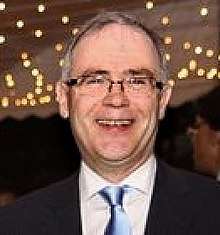Governor of Bermuda
The Governor of Bermuda is the representative of the British monarch in the British overseas territory of Bermuda. The Governor is appointed by the monarch on the advice of the British government. The role of the Governor is to act as the de facto head of state, and he or she is responsible for appointing the Premier and the 11 members of the Senate (the upper house of Bermuda's Parliament).
| Governor of Bermuda | |
|---|---|
 Coat of Arms of Bermuda | |
| Viceroy | |
| Style | His Excellency |
| Residence | Government House |
| Appointer | Monarch of the United Kingdom |
| Term length | At His/Her Majesty's pleasure |
| Formation | 1612 |
| First holder | Richard Moore |
| Website | Page on gov.bm |

 |
|---|
| This article is part of a series on the politics and government of Bermuda |
The Governor is also Commander-in-Chief of Bermuda, formerly in control of a large Bermuda Garrison composed of regular army, Militia, Volunteer, and Territorial units, of which only the Royal Bermuda Regiment remains. Until 1867, the Governor also held the appointment of Vice-Admiral of Bermuda.
The current Governor is John Rankin; he was sworn in on 5 December 2016.
The Governor has his own flag in Bermuda, a Union Flag with the territory's coat of arms superimposed.
History
Bermuda's settlement began in 1609, with the wrecking of the flagship of the Virginia Company, the Sea Venture. Although most of the passengers and crew ultimately completed their voyage to Virginia, the archipelago was permanently settled from that point, and left in the hands of the Virginia Company. The first intentional settlers arrived in 1612, under Richard Moore, whose appointment was officially as the Deputy Governor of Bermuda. Sir Thomas Smith remained in England as the first Governor and Treasurer of Bermuda. A carpenter by trade, Moore ensured the long-term survival of the colony by concentrating on building fortifications, including the first stone forts in the English New World, and developing St. George's Town. Moore brought with him to Bermuda two consecutively numbered boxes. The first, only to be opened in the case of his death, incapacitation or absence from the colony, contained the name of the settler who was to replace him. In the case of that settler also having died, or otherwise being incapable of taking the office, a second was named in the other box. More was also instructed to appoint a Counsell of Six to assist in the governance of the colony. The six appointed Counsellors were Captain Miles Kendall, Captain John Mansfield, Thomas Knight, Charles Caldycot, Edward Waters, and Christopher Carter (Carter was among three men who had first arrived in Bermuda with the 1609 wreck of the Sea Venture. He had remained behind with Robert Waters when the Deliverance and Patience had departed for Jamestown in 1610 with the remainder of the Sea Venture's passengers and crew, and remained again with Robert Waters and Edward Chard, after the Patience had returned from Jamestown and departed once more in the same year for England).
Bermuda was the second permanent English colony established (as an extension of the first, Jamestown, Virginia). Bermuda was administered under Royal charters by the Virginia Company, and its successor, the Somers Isles Company, which appointed the colony's governors until the Crown revoked the charter and took over administration in 1684. With the transfer to the Somers Isles Company in 1615, Sir Thomas Smith remained in England as Governor and Treasurer of Bermuda, and Captain Daniel Tucker was sent to Bermuda in 1616 aboard the George, in consort with the Edwin, to succeed Moore as Deputy Governor. Twenty-four Assistants were also appointed. By the 1630s, the Somers Isles Company had ceased sending Governors to Bermuda and had begun appointing prominent Bermudians, such as William Sayle, to the position.
The Crown maintained the system of government established under the company; an elected parliament (originally a single House of Assembly, which held is first session in 1620) which held its and a privy council under a governor. The Privy Council, made up of the Chief Justice, certain senior civil servants, and appointees, was also known as the Governor's Council and the Legislative Council (most of its responsibilities are now filled by the Cabinet and the Senate of Bermuda, with the Council now only an advisory body for the Governor). The last company-appointed Governor was reappointed by the Crown. In 1707 the British State was created by the union of the Kingdom of England with the Kingdom of Scotland, and Bermuda thereby became a British colony. Since the 1783 independence of Virginia, it has been Britain's oldest colony. Following US independence, Bermuda became an important Royal Navy base, with a large military garrison to guard it.[1] As such, the policy of the government until the closure of the Royal Naval dockyard in 1953 had been to appoint retiring Generals or Admirals as Bermuda's Governor and Commander-in-Chief. On the rare occasions when a civilian was appointed to the role, it was only as Governor – the role of Commander-in-Chief being filled by a serving General or Admiral in Bermuda or Newfoundland. Since the 1950s, those appointed Governor and Commander-in-Chief have tended to be prominent career-politicians at the ends of their political lives.
Prior to the creation of the lower (and, originally, only) house of the Parliament of Bermuda, the House of Assembly, in 1620, the Governors ruled supreme, and were often draconian. Governor Daniel Tucker, formerly of Virginia, who arrived in 1616, was notorious for his harshness, having many islanders hanged, maimed, or whipped on the slightest provocation. One Bermudian, John Wood, was hanged for airing his views on the Governor in church. Governor Tucker's personal boat was reportedly stolen by five islanders, one named Saunders, who left a note saying they were on their way to England, or Davy Jones' Locker, either place being preferable to Bermuda under Tucker's rule. On reaching England, they complained about the harshness of Tucker's rule, though their complaints fell on deaf ears. Governor Tucker also, reportedly, used his oversight of the surveying of Bermuda to enrich himself and future generations of Bermudian Tuckers with prime real estate when he appropriated the overplus (surplus) land left after Richard Norwood's 1616 survey of the colony. Much of this land, forming an estate known as The Grove, would still be in the hands of his relatives during the American War of Independence.
For the remainder of the seventeenth and eighteenth centuries, the real political power in Bermuda lay in the elected parliament and the appointed Council, both dominated by members of Bermuda's wealthy commercial class. By the mid-Seventeenth Century, the Somers Isles Company had ceased sending Governors from overseas, and instead appointed Bermudians such as William Sayle from this same local elite; a policy which ended after the Civil Wars, during which Bermuda tended to the Royalist side. After the regicide, Bermuda was the first colony to recognize Charles II. With control of "the Army" (the local militia), the royalists ousted the Somers Isles Company's Governor, Captain Thomas Turner, and elected John Trimingham as their leader.
Governors who were too high-handed or injudicious in the exercise of their office occasionally fell foul of the local political institutions. Governor Isaac Richier, who arrived in 1691, quickly made himself unpopular with his carousing and criminal behaviour. Bermudian complaints saw him placed in jail, and replaced by Governor Goddard. When Goddard proved worse than Richier, attorney general Samuel Trott had him jailed alongside Richier. The two governors were to be tried before a pair of prominent Bermudians, John Trimmingham and William Butterfield. After Trott called the amateur judges bush lawyers, however, he found himself in St. George's jail alongside the governors. After they confided in him their plan for escape, Trott informed the judges. Richier and Goddard were sent back to England for trial.[2]

At the written request of George Washington, during the course of the American War of Independence, 100 barrels of gunpowder were stolen from a magazine in St. George's and provided to the American rebels. No one was ever prosecuted in relation to this act of treason. The theft had been the result of a conspiracy involving powerful Bermudians, who were motivated as much by Bermuda's desperate plight, denied her primary trading partner and source of food, as by any favourable sentiments they may have had in regard to either the American colonists or their cause. The chief conspirator was Henry Tucker of The Grove (the overplus estate appropriated in 1616 by Governor Daniel Tucker), a Member of the House of Assembly, former Member of the Council, and Militia officer (soon to be promoted to Colonel), who had plotted with Benjamin Franklin while attending the rebel Continental Congress as a delegate for Bermuda. Two of his sons served in the rebel Army and were to achieve high office in the post-War US Government. A third son, also named Henry Tucker, was at the time the President of the Council (and later acting Governor on multiple occasions), and married to the daughter of Governor George James Bruere. Following this, Bermudians and their political institutions were looked at suspiciously by the British Government.

With the buildup of the naval and military bases on the island following American independence, the position of the Governor was enhanced. Despite this, the Governors – appointed by the Crown – remained largely dependent on the Bermudian parliament to pass laws and to provide funds. This fact often found Governors pleading in vain for the required acts of parliament or money to carry out policies determined at Government House, or in London. This was particularly noticeable in the Bermudian Parliament's neglect to maintain militia, which (other than during the course of the American War of 1812), it allowed to become moribund after the build-up of the naval and military base began in 1795.
Attempts to raise militias directly under the control of the Governor, without acts of the local parliament, ultimately failed because the parliament did not provide funds. In the 1860s, it became the policy of the British Government to reduce the costly professional military garrison in Bermuda. As it was not wished to leave the colony, seen more as a naval base, unguarded, this could only be done if the professional soldiers were replaced with part-time Volunteer units. Successive governors were set the task of convincing the Bermudian parliament to raise the required units, but, concerned of being saddled with the cost of maintaining the entire garrison, as well as with the possibility for social disruption that could be caused by raising either racially segregated or integrated units, the Bermudian Parliamentarians simply refused. This state of affairs continued until the Secretary of State for War found a lever (the Princess Hotel) to blackmail the Bermuda Parliament with in 1885, which resulted it finally passing acts in 1892 for the creation of militia and volunteer forces (although the units would be entirely funded by the British Government).[3] Struggles between the Governor and the Parliament would continue to recur. In 1939, the Governor, General Sir Reginald Hildyard, resigned his post, reportedly because the Bermudian Parliament refused to allow him a motor car (motor vehicles having been banned in Bermuda before the First World War, following a petition signed by numerous Bermudians, and by visitors including Woodrow Wilson).
On 10 March 1973, the 121st Governor, Richard Sharples, and his aide-de-camp Captain Hugh Sayers, were assassinated in an attack by a Bermudian black activist named Buck Burrows and an accomplice, Larry Tacklin, who were members of the Black Beret Cadres. Under Bermudian law at the time, premeditated murder was a capital offence, and death sentences were often handed out, though routinely commuted. No death sentence had been carried out since the 1940s. After much debate due to the controversial moral issues raised, the sentence stood despite a 6,000-strong petition from Bermudians to the Queen. Both men were hanged in 1977 for the killings and other murders, sparking riots throughout Bermuda. Buck Burrows explained in his confession that he had killed the Governor to prove that he was not untouchable and that white-dominated politics was fallible. He was also found guilty of murdering the police commissioner, George Duckett, six months earlier on 9 September 1972, and of killing the co-owner and book-keeper of a supermarket called the Shopping Centre, Victor Rego and Mark Doe in April 1973.
List of Governors of Bermuda

- 1612–1616 Richard Moore (Deputy Governor in Bermuda. Sir Thomas Smith remained in England as Governor and Treasurer of Bermuda)
- Between Moore's 1615 departure for England aboard the Welcome and the 1616 arrival of Captain Tucker, the role of acting Deputy Governor was to be rotated monthly among the members of the Counsell of Six: Captain Miles Kendall, Captain John Mansfield, Thomas Knight, Charles Caldicot, Edward Waters, and Christopher Carter, beginning (after the drawing of lots) with Caldicot. At the end of the first month, Caldicot, Knight and Waters departed aboard a frigate to obtain supplies from the West Indies but met with misadventure, and those members of the crew who returned did not do so for years). The monthly succession thereafter was Mansfield, Carter, and Kendall, before starting again with Mansfield
- 1616–1619 Capt. Daniel Tucker (Deputy Governor in Bermuda. Sir Thomas Smith remained in England as Governor and Treasurer of Bermuda)
- 1619–1622 Nathaniel Butler
- 1622–1622 Capt. John Bernard
- 1622–1623 Capt. John Harrison
- 1623–1626 Capt. Henry Woodhouse
- 1626–1629 Capt. Philip Bell
- 1629–1637 Capt. Roger Wood
- 1637–1641 Capt. Thomas Chaddock
- 1641–1642 Capt. William Sayle
- 1642–1643 Capt. Josias Forster
- 1643–1644 Capt. William Sayle
- 1644–1645 Capt. William Sayle
- 1645 Capt. Josias Forster
- 1645–1647 The Triumvirate
- 1647–1649 Capt. Thomas Turner
- 1649–1650 John Trimingham (Elected by the People)
- 1650–1659 Capt. Josias Forster
- 1659–1663 Capt. William Sayle
- 1663–1668 Capt. Florentius Seymour
- 1668–1669 Samuel Whalley
- 1669–1681 Sir John Heydon
- 1681–1682 Capt. Florentius Seymour
- 1682–1683 Henry Durham (Act. Gov.)
- 1683–1687 Col. Richard Coney (last Company appointee. Re-appointed by Crown in 1684)
- 1687–1690 Sir Richard Robinson
- 1691–1693 Isaac Richier
- 1693–1698 Capt. John Goddard
- 1698–1700 Samuel Day
- 1701–1713 Capt. Benjamin Bennett
- 1713–1718 Henry Pulleine
- 1718–1722 Capt. Benjamin Bennett
- 1722–1727 Sir John Hope
- 1727–1728 John Trimingham
- 1728–1737 Capt. John Pitt
- 1737–1738 Andrew Auchinleck
- 1738–1744 Alured Popple
- 1744–1747 Francis Jones
- 1747–1751 William Popple
- 1751–1755 Francis Jones
- 1755–1763 William Popple
- 1763–1764 Francis Jones
- 1764–1780 George James Bruere
- 1780 Thomas Jones
- 1780–1781 George Bruere the younger
- 1782–1788 William Browne
- 1788–1794 Henry Hamilton (Lt. Gov.)
- 1794–1796 James Crawford
- 1796 Henry Tucker
- 1796-1796 Lieutenant-Colonel William Campbell (arrived 22 November, 1796, but died within days)
- 1796–1798 Henry Tucker
- 1798–1803 Colonel (later General) George Beckwith
- 1803–1805 Henry Tucker
- 1805–1806 Major Francis Gore (Lt. Gov.)
- 1806 Henry Tucker
- 1806–1810 Brigadier John Studholme Hodgson
- 1810–1811 Samuel Trott
- 1811–1812 Sir James Cockburn
- 1812 William Smith
- 1812–1816 Brigadier-General (promoted Major-General, 4 June 1813) George Horsford (Lt. Gov.)
- 1814–1816 Sir James Cockburn
- 1816–1817 William Smith
- 1817–1819 Sir James Cockburn
- 1819 William Smith
- 1819–1822 Lieutenant-General Sir William Lumley
- 1822–1823 William Smith
- 1823–1825 Lieutenant-General Sir William Lumley
- 1825–1826 William Smith
- 1826–1829 Lieutenant-General Sir Tomkyns Hilgrove Turner
- 1829 Robert Kennedy (Act. Gov.)
- 1829–1830 Lieutenant-General Sir Tomkyns Hilgrove Turner
- 1830 Robert Kennedy (Act. Gov.)
- 1830–1832 General Sir Tomkyns Hilgrove Turner
- 1832–1835 Colonel Sir Stephen Remnant Chapman
- 1835 Henry G. Hunt (Act. Gov.)
- 1835–1836 Robert Kennedy
- 1836–1839 Colonel (from 1837, Major-General) Sir Stephen Remnant Chapman
- 1839–1846 Lieutenant-Colonel (later Major General) Sir William Reid
- 1846 Lieutenant-Colonel William N. Hutchinson (Act. Gov)
- 1846–1852 Captain (later Admiral) Sir Charles Elliot
- 1852–1853 Lieutenant-Colonel William Hassell Eden, 56th Regiment of Foot (ex-88th Regiment of Foot, later Commandant at Chatham) (Act. Gov.)
- 1853 Lieutenant-Colonel George Philpots, Royal Engineers (Act. Gov.)
- 1853 Major Soulden Oakley, 56th Regiment of Foot (Act. Gov.)
- 1853 Lieutenant-Colonel Thomas C. Robe, Royal Artillery (Act. Gov.)
- 1853 Major Soulden Oakley, 56th Regiment of Foot (Act. Gov.)
- 1853–1854 Captain (later Admiral) Sir Charles Elliot, Royal Navy
- 1854 Lieutenant-Colonel Montgomery Williams, Royal Engineers (Act. Gov.)
- 1854–1859 Colonel Freeman Murray, late 72nd Regiment of Foot
- 1859 Colonel Andrew T. Hemphill, 26th (Cameronian) Regiment of Foot (Act. Gov.)
- 1859–1860 Colonel William Munro, 39th Regiment of Foot
- 1860–1861 Col. Freeman Murray, late 72nd Regiment of Foot
- 1861–1864 Col. Harry St. George Ord
- 1864 Colonel William Munro, 39th Regiment of Foot (Act. Gov.)
- 1864–1865 W.H. Hamley (Lt. Gov.)
- 1865–1866 Colonel Harry St. George Ord (the last Governor to also hold the appointment of Vice-Admiral of Bermuda)
- 1866–1867 W.H. Hamley (Lt. Gov.)
- 1867 Colonel Arnold Thompson, Royal Artillery (Act. Gov.)
- 1867–1870 Colonel Sir Frederick Edward Chapman, Royal Engineers
- 1870 W. F. Brett (Lt. Gov.)
- 1871–1877 Maj. Gen. Sir John Henry Lefroy, Royal Artillery
- 1877 Colonel William Laurie Morrison, Commanding Royal Engineer in Bermuda (Act. Gov.)
- 1877–1882 Brigadier Sir Robert Michael Laffan, Royal Engineers[4] (Gazetted Major-General 2 October 1877, antedated to 8 February 1870. Later Lieutenant-General)
- 1882–1888 Lt. Gen. Thomas L. J. Gallwey
- 1888–1891 Lt. Gen. Edward Newdegate
- 1892–1896 Lt. Gen. Thomas Lyons
- 1896–1901 Lt. Gen. Sir George Digby Barker
- 1902–1904 Lt. Gen. Sir Henry LeGuay Geary[5]
- 1904–1907 Lt. Gen. Sir Robert M. Steward
- 1907–1908 Lt. Gen. Sir Josceline Wodehouse
- 1908–1912 Lt. Gen. Sir Frederick Walter Kitchener
- 1912–1917 Lt. Gen. Sir George M. Bullock
- 1917–1922 Gen. Sir James Willcocks
- 1922–1927 Lt. Gen. Sir J. J. Asser
- 1927–1931 Lt. Gen. Sir Louis Jean Bols
- 1931–1936 Lt. Gen. Sir Thomas Astley Cubitt
- 1936–1939 General Sir Reginald Hildyard
- 1939–1941 Lt. Gen. Sir Denis John Charles Kirwan Bernard
- 1941–1943 The Rt. Hon. Viscount Knollys
- 1943–1945 Honorary Colonel Lord Burghley, Northamptonshire Regiment (Territorial Army) (substantive Major, Reserve of Officers)
- 1945 – May 1946 William Addis (acting)[6]
- May 1946–1949 Admiral Sir Ralph Leatham
- 1949–1955 Lt. Gen. Sir Alexander Hood
- 1955–1959 Lt. Gen. Sir John Woodall
- 1959–1964 Maj. Gen. Sir Julian Gascoigne
- 1964–1972 The Rt. Hon. Lord Martonmere
- 1972–1973 Sir Richard Sharples (assassinated)
- 1973 – 7 April 1977 Sir Edwin Leather
- 7 April 1977 – 6 September 1977 Peter Lloyd (acting – 1st tenure)[6]
- 1977–30 December 1980 The Hon. Sir Peter Ramsbotham
- 1 January 1981 – February 1981 Peter Lloyd (acting – 2nd tenure)[6]
- February 1981 – 15 March 1983 Sir Richard Posnett[6]
- 14 Feb. 1983 – July 1983 Mark Herdman (acting) – Acting for Governor Posnett until 15 March 1983[6]
- 1983–1988 The Rt. Hon. Viscount Dunrossil
- 1988–1992 Major-Gen Sir Desmond Langley
- 25 August 1992 – 4 June 1997 The Rt. Hon. Lord Waddington
- 4 June 1997 – 27 November 2001 Thorold Masefield
- 27 November 2001 – 11 April 2002 Tim Gurney (acting)[6]
- 11 April 2002 – 12 October 2007 Sir John Vereker
- 12 October 2007 – 12 December 2007 Mark Andrew Capes (acting)[6]
- 12 December 2007 – 18 May 2012 Sir Richard Gozney
- 18 May 2012 – 23 May 2012 David Arkley (acting)
- 23 May 2012 – 2 August 2016 Hon. George Fergusson
- 2 August 2016 – 5 December 2016 Ginny Ferson (acting)
- 5 December 2016 – present John Rankin
Sources
Bermuda and Great Britain; Bermuda Online Portal
- "The Andrew and the Onions: The Story of the Royal Navy in Bermuda, 1795–1975", Lt. Commander Ian Strannack, The Bermuda Maritime Museum Press, The Bermuda Maritime Museum
- "Bermuda in Three Colours", Carveth Wells. Robert M. McBride & Company, New York. 1935.
- "Defence, Not Defiance: A History of the Bermuda Volunteer Rifle Corps", Jennifer M. Ingham (now Jennifer M. Hind), ISBN 0-9696517-1-6. Printed by The Island Press Ltd., Pembroke, Bermuda. Itself using as a source the unique, typescript "History of The Bermuda Volunteer Rifle Corps, 1891–1933", held at the Bermuda Library, in Hamilton.
- May, Alex. "Laffan, Sir Robert Michael". Oxford Dictionary of National Biography (online ed.). Oxford University Press. doi:10.1093/ref:odnb/15875. (Subscription or UK public library membership required.)
- "No. 27398". The London Gazette. 17 January 1902. p. 385.
- "Countries Ba-Bo: Bermuda". Rulers.org. Retrieved 3 September 2015.

.svg.png)